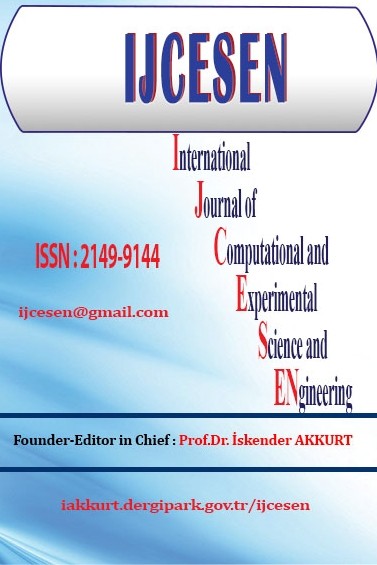Analysis of Laser Pulse Heating Model Using the Finite Element Analysis
Analysis of Laser Pulse Heating Model Using the Finite Element Analysis
Finite Element Method (FEM), Rectangular discretization Triangular discretization, Lagrange interpolation function, Laser,
___
- [1] D S Burnett., Finite Element Analysis, from Concept to Application. Addison Wesley, New Jersey, 1987.[2] J.N. Reddy, An Introduction to the Finite Element Method. Third ed. McGraw-Hill. 2006. [3] J.A. Akpobi, and E.D., Akpobi. “A finite element analysis of the distribution of velocity in viscous incompressible fluids using the Lagrange interpotation function”, Journal of Applied Science, vol.11, pp.31-38, 2007.[4] J.A. Akpobi, and E.D., Akpobi. “Finite element solution of the Boussinesq wave equation”, Journal of the Nigeria association of Mathematical physics, vol.11, pp. 223-228. 2007.[5] H. Shokouhmand and S.M.A. Noori., “Finite element analysis of mixed convection heat transfer through a vertical wavy isothermal channel”, proceedings of the world congress on Engineering, vol. 2, pp. 1415-1420, 2010.[6] R. Rajamani, C. Srinivas, and K. N. Seetharamu, “Finite Element Analysis of convective Heat transfer in porous media”, International journal for Numerical Methods in Fluids. Vol.11 (3), pp. 331-339, 1990.[7] Johan Meijer,.”Laser beam machining (LBM), state of the art and new opportunities”, Journal of Materials Processing Technolog vol. 149 pp. 2–17, 2004.[8] U. Paek, and F. P. Gagliano “Thermal analysis of laser drilling”, Journal of Quantum Electronics, vol.8, pp.112-119, 1972.[9] X.Liu, D. Du, and G. Mourou, “ Laser ablation and micro machining with ultrashort laser pulses, Journal of Quantum Electron. Vol. 33, pp. 1706-1716, 1997.[10] M. F. Modest and H. Abiakans, “Evaporative cutting of a semi-infinite body with a moving cw laser”, Journal of Heat Transfer, vol. 108 pp. 602-607, 1988.[11] P. S. Wei and J. Y. Ho, Energy consideration in high energy beam drilling, International Journal of Heat and Mass Transfer, vol. 33, pp. 2207-2217, 1990. [12] S.Y. Bang and M. F. Modest, “Multiple reflection effects on evaporative cutting with a moving cw laser”, Journal of Heat Transfer, vol. 113, pp. 663-669, 1991.[13] B. S. Yilbas and I. Z. Naqvi, “Laser heating including the phase change process and thermal stress generation in relation to drilling”, Journal of Engineering Manufacture, vol. 217(B) pp. 977-991, 2003. [14] B. S. Yilbas, M. Saad, and S. Z. Shuja, “Laser pulse heating: modelling of cavity formation”, Journal of Mechanical Engineering Science, vol. 221(C) pp. 307-328, 2006.[15] B. S. Yilbas, “Analytical solution for time unsteady laser pulse heating of semi-infinite solid”, International journal of Mechanical Science, vol. 39(6), pp. 671-682, 1997.
- Başlangıç: 2015
- Yayıncı: Prof.Dr. İskender Akkurt
Study on Determination Method of Inter Well Pumping System for Liquid Supply Shortage Well
Xingyuan LİANG, Jiang LEİ, Yi LU
Thermodynamics of the Quark Gluon Plasma in the Early Universe
Ali SANCAKTAR, Sebahattin KIRTAY, Aliye ARABACI
The Determination of the Uniformity in Road Lighting Using Artificial Neural Networks
Mehmet KAYAKUŞ, İsmail Serkan ÜNCÜ
Boubaaya RABAH, Omar ALLAOUI, Mokhtar DJENDEL, Younes BENARIOUA, Zied DRISS
Microstructure & Tribological Performance of Alumina-3wt% Titania Coatings Produced by APS
Mokhtar DJENDEL, Omar ALLAOUI, Mourad MAAZOUZ, Rabah BOUBAAYA
Analysis of Laser Pulse Heating Model Using the Finite Element Analysis
Erhuvwuvoke EBOJOH, John Ajokpaoghene AKPOBI, Kelechi NWOSU
Xingyuan LİANG, Fujian ZHOU, Bo ZHENG, Tianbo LİANG
Shale Gas Technical Development and Innovation
Xingyuan LİANG, Ji HU, Qishuang ZHOU, Lei DU, Qiang Lİ, Baofeng Lİ, Yuan CHENG
